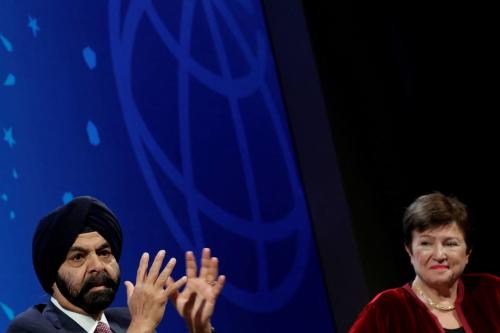In assessing the communiqué of the G-20 summit on the financial crisis in Washington, as well as some of the press conferences held after the meeting, three distinct parts can be seen: past, present, and future. Regarding the past, it seems that heads of state did not want to get into the crucial issues without some finger pointing on who and what caused the crisis. For the present, there was also a sense of satisfaction communicated about how they are handling the current challenges by following similar fiscal and monetary policies. Looking to the future, discussion centered on what to do so that a global crisis of this scale does not happen again.
The past.
The rear view mirror language reflects some compromises between Europe and the U.S. on the importance of free markets for innovation and economic efficiency, and the problems associated with ineffective regulation. It is constructive that heads of state agreed that it was policy-makers, regulators and supervisors in some advanced (these are the two key words) countries that were not up to the job. The reprimand came with a new obligation. From now on, all G-20 members must allow the IMF to oversee their financial sectors through the Financial Sector Assessment Program (FSAP). If this commitment is really enforced, the IMF will play a more active role in discussing the policies in the developed world, with a gain in terms of its legitimacy.
The present. Regarding the more urgent issues, the G-20 overwhelming supports policy responses to stimulate domestic demand in cases where there are not serious inflationary or debt sustainability problems. This is easier said than done in many emerging and developing countries that are being cut off from international financial markets. The IMF needs to step in and act as lender of last resort.
But the IMF needs some additional resources to do that convincingly. Although the need of additional funds was mentioned, the meeting did not provide concrete and necessary answers to the when, who, and how. When will the IMF run out of steam? Which countries are going to provide the additional funds? Is the IMF going to raise its capital base, or keep its current capital structure and get loans from surplus economies, like the $100 billion credit line Japan just announced? Expectations regarding Saudi Arabia’s additional support to the IMF did not come true. China also played a passive role, allowing Japan to move first and continue to be perceived as Asia’s premier power.
Even if the additional capital issues were not discussed, an important aspect to highlight is that the G-20 governments agreed to reform the Bretton Woods Institutions so that emerging and developing economies have greater voice and representation, reflecting changes in “economic weights in the world economy.” This is an important step.
The future. The rest of the meeting was devoted to the formulation of an action plan in order to avoid a crisis like this one to happen again in the future. Ministers of Finance were delegated the task of convening expert teams to review issues like global accounting standards and mitigating the pro-cyclical bias in regulatory policy. The key words were coordination and cooperation, as well as the adoption of international standards. Not a global super regulator. This was expected. Countries are not ready to surrender sovereignty on these areas.
To end with a positive note, heads of state unanimously rejected protectionism and asked their trade ministers the need to reach agreement, before the end of the year, on the critical issues for the conclusion of the WTO’s Doha Development Agenda. If adopted, this could be the most significant and tangible result of this first G-20 meeting.



Commentary
Op-edAssessing the Key Outcomes of the G-20 Summit
November 17, 2008